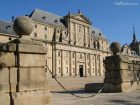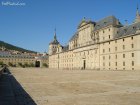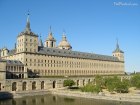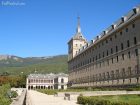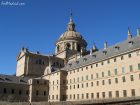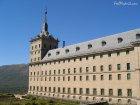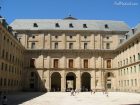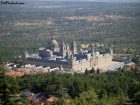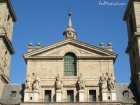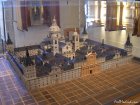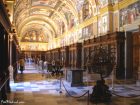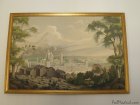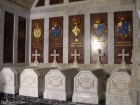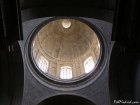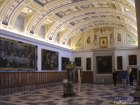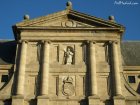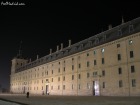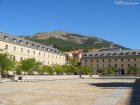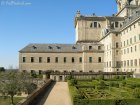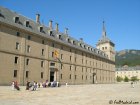 |
Home Info History Transportation Restaurants Top-10 Events Nightlife Walks Safety Photos
Wine  |
nobility without arrogance, majesty without ostentation."
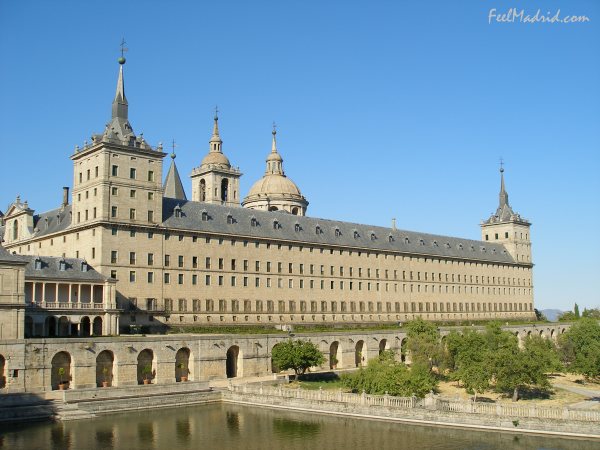
The Monastery of El Escorial, located some 30 miles northwest of Madrid in the foothills of the Sierra de Guadarrama, was built as a monument to commemorate the Spanish victory over the French in the battle of Saint Quentin on 10 August 1557 (feast day of St. Lawrence). Felipe II himself selected the site for the monastery, 1,028 meters (3,372 feet) above sea level, and personally oversaw the progress of the project. The monastery was initially designed by architect Juan Bautista de Toledo, but after his death in 1567, his assistant Juan de Herrera continued the work. Construction lasted 21 years from 1563 to 1584, and for many years after its completion, El Escorial Monastery was the largest building in the world.
The rectangular plant of this colossal building of granite measures 207 x 161 meters (680 x 528 feet). The four towers in the corners are 55 meters (180 feet) high. The two campaniles are 72 meters (236 feet) high, and the cupola of the basilica is 92 meters (302 feet) high. The whole complex has some 24 kilometers (14.9 miles) of corridors.
The building is structured around a main axis that extends eastwards from the main façade through the Library, the Kings' Courtyard, the Basilica, and the Palace of Felipe II. In addition, the complex includes a Monastery, a Seminary, a School, and the Kings' Pantheon beneath the high altar of the Basilica.
The decoration of the Monastery was entrusted to prominent Italian painters of the time who were responsible for the Gallery of Battles and the Library among other rooms. Works of Titian, Bosch, El Greco, and Velázquez also hang in the Chapter Rooms and Sacristy. Overall there are about 1,600 paintings and more than 500 frescoes in walls and ceilings. The Monastery has an interesting Museum of Painting and Architecture as well.
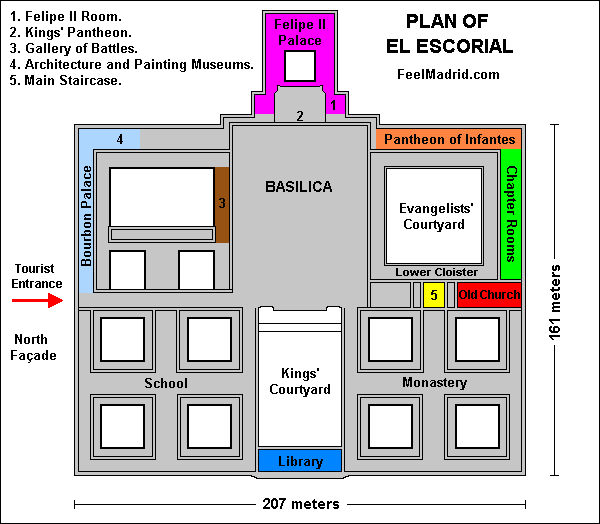
Architecture Museum.
Located in the basement below the Bourbon Apartments, the Museum of Architecture displays the different materials, machinery, tools, cranes, and plans used in the construction of the Monastery as well as scale models.
Painting Museum.
Exhibits a splendid collection of works from the Italian (Titian, Tintoretto, Veronese, Giordano) and Spanish (Fernández Navarrete, Ribera, Zurbarán) schools.
Of particular interest are the "Calvary" of Van der Weyden, the "Martyrdom of Saint Maurice and the Theban Legion" by El Greco, and the 16th century Flemish tapestries.
Palace of Felipe II.
Built around the apse of the basilica on the east side of the building, the Palace of Felipe II includes the rooms (Habsburg Apartments) used by the King during his stay at El Escorial.
The bedroom where Felipe II died in 1598 is preserved almost as it was four centuries ago.
Gallery of Battles.
This impressive gallery commemorates the most important military campaigns of Felipe II including the battle of Saint Quentin.
It is decorated with frescoes made by Italian painters of the time.
Palace of the Bourbons.
In the 18th century, during the reign of Carlos III, an entire section of the building was remodeled to house the Bourbon apartments.
There is an excellent collection of tapestries made at the Royal Factory of Santa Bárbara woven from cartoons by Goya.
Royal Pantheon.
Located directly under the high altar of the basilica, this is the burial place for the kings of Spain from Carlos I to the present day, with the exception of Felipe V and Fernando VII.
Lower Cloister and Main Staircase.
These areas surrounding the Courtyard of the Evangelists, comprise 62 frescoes and paintings representing religious scenes, original works by Tibaldi, Cambiasso, Carvajal, Cincinnato and Barroso.
The Staircase ceiling is decorated with frescoes by Luca Giordano (Glory of the Spanish Habsburgs).
Library.
The Regia Laurentina is one of the most important historic libraries in the world.
It contains almost 45,000 printed works from the 15th and 16th centuries, and some 5,000 manuscripts in Arabic, Latin, and Spanish.
Its original furnishings are in an excellent state of preservation.
The ceiling is decorated with frescoes by Italian Pellegrino Tibaldi related to the sciences and learning.
Basilica.
The basilica takes the form of a Greek cross.
It contains 45 altars, which have pairs of paintings of saints by Fernández Navarrete, Sánchez Coello, Carvajal and Urbina.
Impressive marble Christ by Cellini.
High altar with reredos in rich marble and jasper, decorated with bronze figures by Leone and Pompeo Leoni and paintings by Tibaldi and Zuccaro.
Tabernacle by Trezzo.
On either side sculptures by Leoni of praying figures depicting Carlos I and Felipe II with their respective families.
Upper Choir with stalls designed by Juan de Herrera.
Ceiling frescoes by Cambiasso and Giordano.
The monastery and site of El Escorial is a UNESCO World Heritage Site since 1984, and has been visited by the Pope Benedict XVI. Photographing inside the building is not permitted anymore. In 2005, the Monastery of El Escorial was visited by 545,000 people.
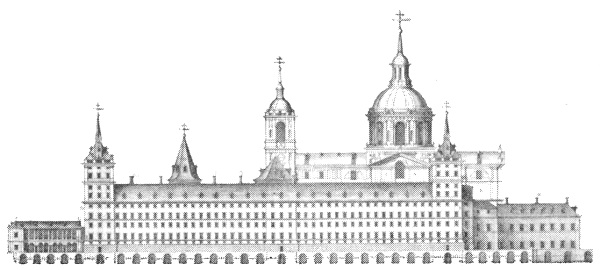
Drawing of El Escorial Monastery as seen from the south side.
Visiting El Escorial. How to Get to El Escorial.
The town of San Lorenzo de El Escorial can be reached from Madrid either by bus from Moncloa Interchange (lines 661 and 664), or by train from Atocha and Chamartín Stations. In any case the trip from Madrid takes about an hour. El Escorial Bus Station is only a five minute walk away from the monastery. However, if you arrive at El Escorial by train, you will then have to take a bus or walk for 20 minutes uphill to get to the monastery.
The monastery opens at 10:00 am, and a visit takes about 2 hours. Allow at least another hour to walk through the main esplanade (known as La Lonja), explore the surrounding gardens, and contemplate the beautiful landscapes. Also feel free to visit the tourist information office that is located in Calle Grimaldi nº 2, just in front of the Monastery on the north side.
Monastery Visiting Times:
October-March: From 10:00 am to 18:00 pm.
April-September: From 10:00 am to 19:00 pm.
Mondays closed.
Entrance fees: 10 Euros.
Wednesdays and Thursdays: Free from 15:00 pm to 19:00 pm for EU Citizens with identification card.
Telephone for information: (+34) 91 890 59 04
Telephone for reservations: (+34) 91 890 59 05
Website: http://www.patrimonionacional.es
Photos of El Escorial. Monastery and Surroundings.
El Escorial Accommodation, Lodging, Hotels, and Hostels. Where to Sleep.
Hotel Victoria Palace **** - Calle Juan de Toledo, 4. - 100 meters from the Monastery.
Best Western Hotel Florida *** - Calle Floridablanca, 12. - 50 meters from the Monastery.
Hotel Miranda Suizo *** - Calle Floridablanca, 18-20. - 50 meters from the Monastery.
Hotel Los Lanceros *** - Calle Calvario, 57-49. - Off Bus Station.
Hotel Parrilla Principe *** - Calle Mariano Benavente, 12. - 50 meters from the Monastery.
Hostal Cristina ** - Calle Juan de Toledo, 6. - Off Bus Station.
Hostal Vasco ** - Plaza de Santiago, 11. - 200 meters from the Monastery.
Posada Don Jaime - Calle San Antón, 24. - 200 meters from the Monastery.
Camping Caravaning Bungalow Park El Escorial - Carretera M-600 Km 3,5.
El Escorial Restaurants. Where to Eat.
Restaurante La Cueva - Calle San Antón, 4. - 100 meters from the Monastery.
Restaurante Fonda Genara - Plaza de San Lorenzo, 2. - 100 meters from the Monastery.
Restaurante Alaska - Plaza de San Lorenzo, 4. - 100 meters from the Monastery.
Restaurante Cañada Real - Calle Floridablanca, 30. - 100 meters from the Monastery.
La Buganvilla - Calle del Rey, 41. - 150 meters from the Monastery.
Restaurante Horizontal - Camino Horizontal s/n. - Over the hill to the west of the Monastery.
| Home Info History Transportation Restaurants Top-10 Events Nightlife Walks Safety Photos Wine Quiz Contact |
